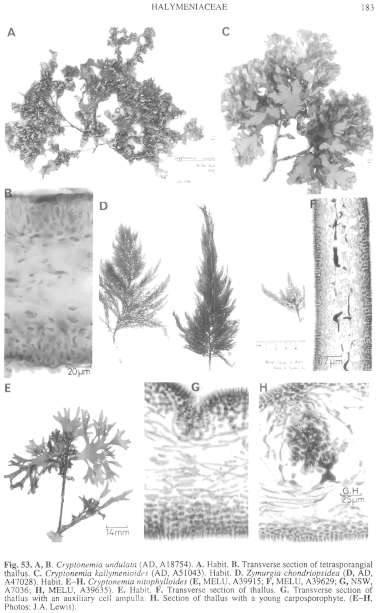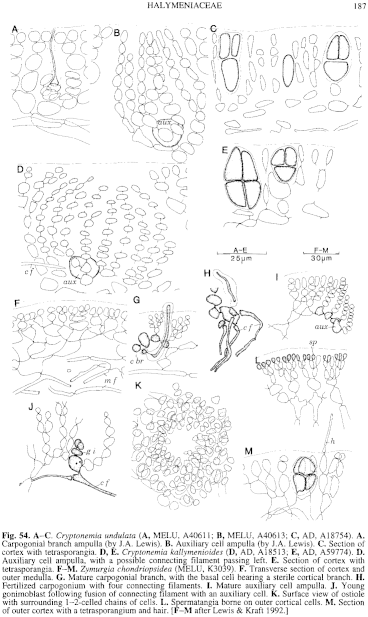|
|
|
|
|
|||||||||||
|
Electronic Flora of South Australia Species Fact Sheet
Phylum Rhodophyta – Class Florideophyceae – Order Gigartinales – Family Halymeniaceae
Synonyms
Halymenia kallymenioides Harvey 1855a: 556.
Sebdenia kallymenioides (Harvey) De Toni 1900: 533.
Halymenia cliftonii Harvey 1859a: pl. 103; 1863: xlvi (in part). Kützing 1866: 33, pl. 93c, d.
Thallus (Fig. 53C) medium red-brown, with a perennial, branched, basal stalk, becoming relatively massive and showing growth rings in older parts, (2–) 5–15 cm high and 4–10 (–20) mm thick, compressed above, bearing 1–5 fronds from the apex of each branch. Fronds probably seasonal, expanding rapidly from the stalk apices, 5–26 cm long and 5–30 cm broad, 120–300 µm thick, complanate, foliose and variously branched with the margin usually becoming deeply indented and lobed, with the surface conspicuously mottled. Holdfast 2–10 (–30) mm across; epilithic. Structure of a relatively thin cortex 2–5 cells thick, outer cells 3–5 µm across and slightly elongate in section, with ovoid inner cells (becoming separated and slightly stellate), and a lax filamentous medulla of transverse and irregular filaments 2–4 µm in diameter, becoming moderately dense in older parts and with numerous prominent refractive ganglionic cells. Rhodoplasts discoid to elongate, several per cell.
Reproduction: Carpogonial branch ampullae not seen. Auxiliary cell ampullae (Fig. 54D) in the inner cortex, subspherical, with numerous fairly long secondary filaments forming a prominent ampulla, converging above. Carposporophyte with a persistent basal auxiliary cell and 2–3 lobes of carposporangia, with a slight ampullary involucre and small ostiole. Spermatangia unknown.
Tetrasporangia (Fig. 54E) scattered, cut off from outer cortical cells which divide to form irregular rows of 1–3 cells surrounding the sporangia, 16–25 µm long and 10–16 µm in diameter, cruciately divided.
Type from Fremantle, W. Aust. (Harvey, Tray, set 174); holotype in TCD; slide in AD, A18513.
Selected specimens: Geraldton, W. Aust., drift (Borowitzka, 22.iv.1979; MELU, A39615). Port Denison, W. Aust., drift (Kraft 3969, 14.xii.1971; AD, A41790). Cape Vlamingh, Rottnest I., W. Aust., 14 m deep (AIMS-NCI, Q66C 2703-F, 15.iii.1989; AD, A59774). Green I., Rottnest I., W. Aust., 5 m deep (Engler, 6.ix.1979; AD, A51043). Hamelin Bay, W. Aust., 6 m deep (Kraft & Ricker, 13.viii.1979; MELU, K6969). Seamount off Cannan Reefs, S. Aust., 22–30 m deep (Branden, 22.i.1991; AD, A61203).
Distribution: Geraldton to Hamelin Bay, W. Aust., and Cannan Reefs, S. Aust.
Taxonomic notes: The morphology and structure of C. kallymenioides have been described by Scott et al. (1982), emphasising the perennial woody stalks (rarely collected except with SCUBA) which grow vertically or horizontally from the roofs or sides of undercuts (Kraft, pers. comm.). While the structure and reproduction agree with Cryptonemia, the thallus is more foliose and more mucilaginous than the more typical species (e.g. the type and C. undulata). C. kallymenioides reaches the southern Australian region in a probable (but sterile) specimen from Cannan Reefs, S of the Isles of St Francis, S. Aust. Records of Chapman (1979, p. 289) from Borneo and New Zealand are clearly incorrect.
References:
CHAPMAN, V.J. (1979). The marine algae of New Zealand. Part DI Rhodophyceae. Issue 4: Gigartinales. (Cramer: Germany.)
DE TONI, G.B. (1900). Sylloge Algarum omnium hucusque Cognitarum. Vol. 4. Florideae. Sect. 2, pp. 387–776. (Padua.)
HARVEY, W.H. (1855a). Some account of the marine botany of the colony of Western Australia. Trans. R. Ir. Acad. 22, 525–566.
HARVEY, W.H. (1859a). Phycologia Australica. Vol. 2, Plates 61–120. (Reeve: London.)
HARVEY, W.H. (1863). Phycologia Australica. Vol. 5, Plates 241–300, synop., pp. i-lxxiii. (Reeve: London.)
KÜTZING, F.T. (1866). Tabulae Phycologicae. Vol. 16. (Nordhausen.)
SCOTT, F.J., WETHERBEE, R. & KRAFT, G.T. (1982). The morphology and development of some prominently stalked southern Australian Halymeniaceae (Cryptonemiales, Rhodophyta). I. Cryptonemia kallymenioides (Harvey)Kraft comb. nov. and C. undulata Sonder. J. Phycol. 18, 245–257.
SCOTT, F.J., WETHERBEE, R. & KRAFT, G.T. (1982). The morphology and development of some prominently stalked southern Australian Halymeniaceae (Cryptonemiales, Rhodophyta). I. Cryptonemia kallymenioides (Harvey)Kraft comb. nov. and C. undulata Sonder. J. Phycol. 18, 245–257.
The Marine Benthic Flora of Southern Australia Part IIIA complete list of references.
Publication:
Womersley, H.B.S. (14 January, 1994)
The Marine Benthic Flora of Southern Australia
Rhodophyta. Part IIIA, Bangiophyceae and Florideophyceae (to Gigartinales)
Reproduced with permission from The Marine Benthic Flora of Southern Australia Part IIIA 1994, by H.B.S. Womersley. Australian Biological Resources Study, Canberra. Copyright Commonwealth of Australia.
Illustrations in Womersley Part IIIA, 1994: FIGS 53C, 54D, E.

Figure 53 enlarge
Fig. 53. A, B. Cryptonemia undulata (AD, A18754). A. Habit. B. Transverse section of tetrasporangial thallus. C. Cryptonemia kallymenioides (AD, A51043). Habit. D. Zymurgia chondriopsidea (D, AD, A47028). Habit. E–H. Cryptonemia nitophylloides (E, MELU, A39915; F, MELU, A39629; G, NSW, A7036; H, MELU, A39635). E. Habit. F. Transverse section of thallus. G. Transverse section of thallus with an auxiliary cell ampulla. H. Section of thallus with a young carposporophyte. (E–H, Photos: J.A. Lewis).

Figure 54 enlarge
Fig. 54. A–C. Cryptonemia undulata (A, MELU, A40611; B, MELU, A40613; C, AD, A18754). A. Carpogonial branch ampulla (by J.A. Lewis). B. Auxiliary cell ampulla (by J.A. Lewis). C. Section of cortex with tetrasporangia. D, E. Cryptonemia kallymenioides (D, AD, A18513; E, AD, A59774). D. Auxiliary cell ampulla, with a possible connecting filament passing left. E. Section of cortex with tetrasporangia. F–M. Zymurgia chondriopsidea (MELU, K3039). F. Transverse section of cortex and outer medulla. G. Mature carpogonial branch, with the basal cell bearing a sterile cortical branch. H. Fertilized carpogonium with four connecting filaments. I. Mature auxiliary cell ampulla. J. Young gonimoblast following fusion of connecting filament with an auxiliary cell. K. Surface view of ostiole with surrounding 1-2-celled chains of cells. L. Spermatangia borne on outer cortical cells. M. Section of outer cortex with a tetrasporangium and hair. [F–M after Lewis & Kraft 1992.]

|
Email Contact: State Herbarium of South Australia |

|